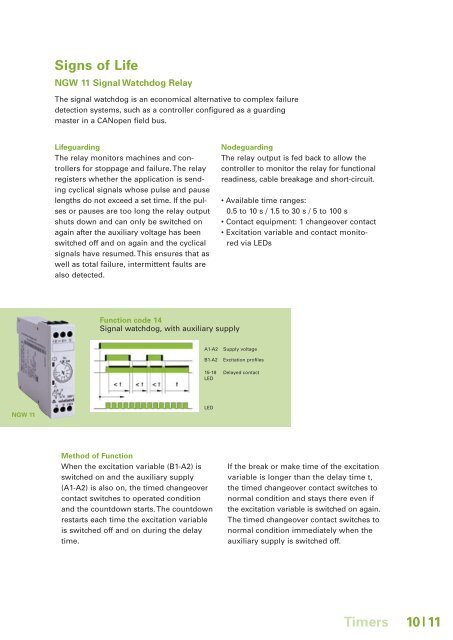NGG timers - Wieland Electric, Inc.
NGG timers - Wieland Electric, Inc.
NGG timers - Wieland Electric, Inc.
You also want an ePaper? Increase the reach of your titles
YUMPU automatically turns print PDFs into web optimized ePapers that Google loves.
NGW 11<br />
Signs of Life<br />
NGW 11 Signal Watchdog Relay<br />
The signal watchdog is an economical alternative to complex failure<br />
detection systems, such as a controller configured as a guarding<br />
master in a CANopen field bus.<br />
Lifeguarding<br />
The relay monitors machines and controllers<br />
for stoppage and failure. The relay<br />
registers whether the application is sending<br />
cyclical signals whose pulse and pause<br />
lengths do not exceed a set time. If the pulses<br />
or pauses are too long the relay output<br />
shuts down and can only be switched on<br />
again after the auxiliary voltage has been<br />
switched off and on again and the cyclical<br />
signals have resumed. This ensures that as<br />
well as total failure, intermittent faults are<br />
also detected.<br />
Function code 14<br />
Signal watchdog, with auxiliary supply<br />
Method of Function<br />
When the excitation variable (B1-A2) is<br />
switched on and the auxiliary supply<br />
(A1-A2) is also on, the timed changeover<br />
contact switches to operated condition<br />
and the countdown starts. The countdown<br />
restarts each time the excitation variable<br />
is switched off and on during the delay<br />
time.<br />
Nodeguarding<br />
The relay output is fed back to allow the<br />
controller to monitor the relay for functional<br />
readiness, cable breakage and short-circuit.<br />
• Available time ranges:<br />
0.5 to 10 s / 1.5 to 30 s / 5 to 100 s<br />
• Contact equipment: 1 changeover contact<br />
• Excitation variable and contact monitored<br />
via LEDs<br />
A1-A2 Supply voltage<br />
B1-A2 Excitation profiles<br />
15-18 Delayed contact<br />
LED<br />
LED<br />
If the break or make time of the excitation<br />
variable is longer than the delay time t,<br />
the timed changeover contact switches to<br />
normal condition and stays there even if<br />
the excitation variable is switched on again.<br />
The timed changeover contact switches to<br />
normal condition immediately when the<br />
auxiliary supply is switched off.<br />
T imers<br />
10 | 11




